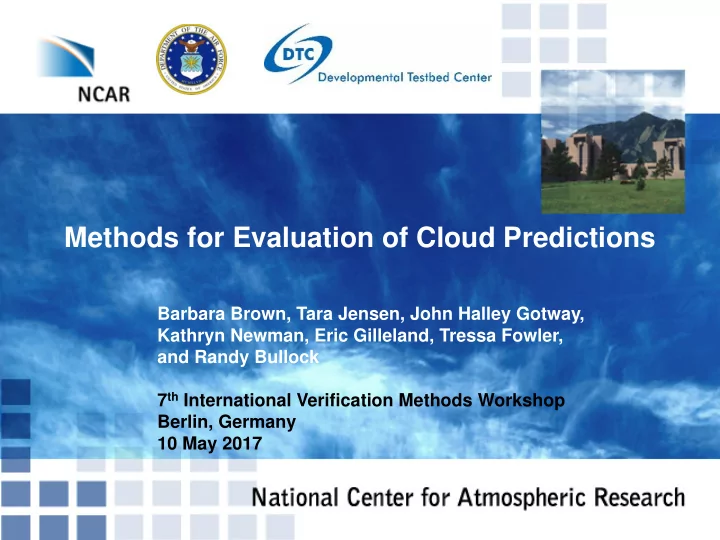

Methods for Evaluation of Cloud Predictions Barbara Brown, Tara Jensen, John Halley Gotway, Kathryn Newman, Eric Gilleland, Tressa Fowler, and Randy Bullock 7 th International Verification Methods Workshop Berlin, Germany 10 May 2017
Motivation and Goals • Motivation Clouds have important impacts on activities of the US Air Force and are a prime focus of the 557 th Weather Wing Skill of cloud forecasts impact decision making (e.g., uncertainty in cloud cover predictions can change operational decisions) • Goals Long-term : Create a meaningful cloud verification “index” for AF applications Short-term : Identify useful components of such an index
Approach 1. Standard methods based on traditional metrics (continuous, categorical) 2. Investigate object-based and distance metrics to provide forecast quality information that Provides diagnostic, user- relevant information Includes methods not subject to “hazards” of traditional verification (e.g., entanglement of spatial displacement with other errors) Initial focus on CONUS, fractional coverage (TCA = Total Cloud Amount) Secondary: Global forecasts
Verification Questions • Which methods provide useful information about the performance of cloud forecasts? • Do spatial methods have a role to play in evaluation of clouds? • Would distance metrics be a useful addition to the cloud verification toolbox?
Conclusions First… • Continuous methods (RMSE, MAE, etc.) do not provide much useful information regarding TCA performance – primarily due to discontinuous nature of clouds Edges Tendency of products toward 0 or 100% values • Point observations are less useful overall than satellite- based analyses due to limited availability globally • Categorical methods (POD, FAR, etc.) are more useful for answering relevant questions about cloud occurrence Especially when presented in a diagnostic multivariate form • Object-based methods have promise of providing useful information – when configured appropriately • Distance metrics can provide interesting diagnostic information – but need to be explored more
Observations, Analyses, and Forecasts • “Observations” and Analyses WWMCA WWMCA (gridded World-Wide Merged Cloud Analysis) WWMCA-R (WWMCA updated in post- analysis with all obs available) • Forecasts 2 global models (72 h) • GALWEM (AF implementation of UK Unified Model) • GFS (NCEP Global Forecast System) DCF (Diagnostic Cloud Forecast) GALWEM • Bias-corrected GALWEM and GFS ADVCLD : Advection (persistence) model (9 h) • Sample data for 4 seasons (1 week each) • NCEP grid 212 (polar stereographic; 40 km) • Model Evaluation Tools (MET) and Spatial- Vx R package used for all analyses
Gridded comparisons: Categorical statistics Performance Diagrams using WWMCA-R as the verification grid Best GFS Raw: <22.5 , <35 , <50 GFS DCF POD GFS Raw: >60 , >75 Lines of equal Success Ratio = 1-FAR bias N. America Lines of equal CSI After Roebber (2009)
Performance Diagram: Multiple Categorical Measures Cloudy – F24 Best Models: Masks: GFSDCF 1. AVHRR GFSRAW 2. DMSP UMDCF 3. GEO UMRAW POD 4. MODIS Analysis: World Wide Merged Cloud Analysis (WWMCA) Lines of -reanalysis equal bias Success Ratio = 1-FAR Lines of Global equal CSI
Performance Diagram: Multiple Categorical Measures Clear – F72 Best Masks: Models: 1. Land GFSDCF GFSRAW 2. Water UMDCF UMRAW POD Analysis: World Wide Merged Cloud Analysis (WWMCA) Lines of -reanalysis equal bias Success Ratio = 1-FAR Lines of Global equal CSI
Application of MODE MODE (Method for Object-based Diagnostic Evaluation) process: • Identify relevant features in obs and forecast fields • Use fuzzy logic engine to match clusters of forecasts and observed features • Summarize characteristics of objects and differences between pairs of objects
MODE Object-Based Approach WWMCA GALWEM 11 November 2015; Cloudy Threshold (TCA > 75)
• Some displacement of all clusters • Large area differences, for some objects … Etc.
Example MODE summary result: Centroid Distance Centroid Distance (grid points) Less More Cloudy Cloudy
Global MODE Clear Adjustments for Cloudy Global application of MODE: • Larger convolution radius • Changes in weights and interest values for centroid distance and area ratio for matching
Global MODE Cluster Areas Clear Cloudy UMRaw GFSRaw UMDCF GFSDCF No Pairwise significant differences for Cloudy Cluster Areas All Pairwise differences for Raw models significant for Clear Cluster Areas
Mean Error Distance Examine average error distance from all Other promising obs points to the nearest forecast point approaches: [ MED(forecast, obs) ], and from all • Hausdorff and Baddeley forecast points to the nearest obs point [ MED(obs, forecast) ] Delta metrics • Above diagonal: Misses • Image warping • Below diagonal: False alarms • Geometric measures Gilleland 2017 (WAF)
Conclusions • Categorical methods are the most useful “traditional” approach for evaluating TCA Diagnostic plots (box plots, performance diagrams) aid in interpretation of results • Spatial and distance metrics have many benefits and are promising approaches MODE configurations depend greatly on scale of evaluation (e.g., global vs. regional) • On a global scale, MODE is especially useful for evaluation of non-cloudy areas
Thank You
Recommend
More recommend